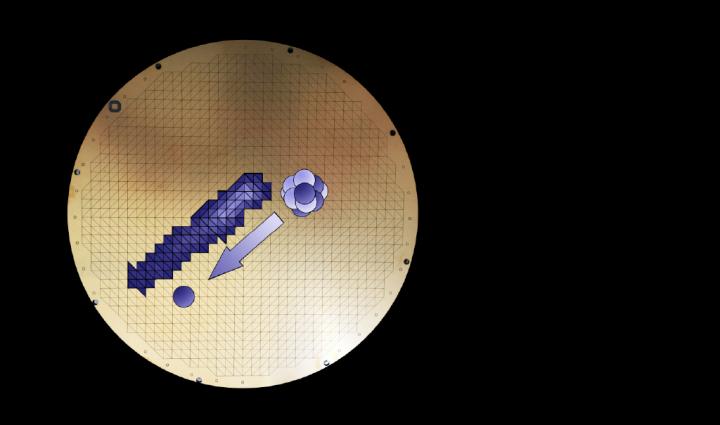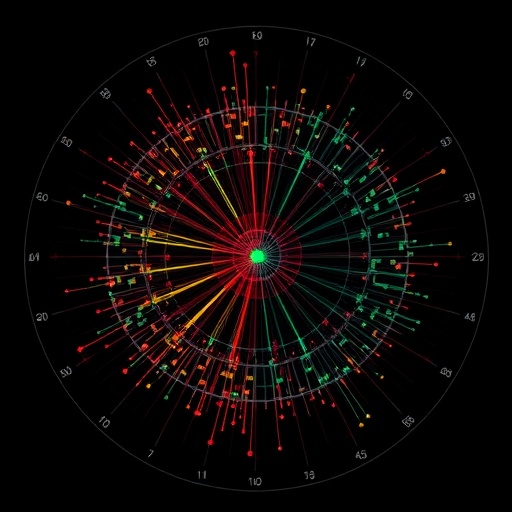
Credit: National Superconducting Cyclotron Laboratory
EAST LANSING, Mich. – Researchers from the National Superconducting Cyclotron Laboratory (NSCL) at Michigan State University (MSU) and TRIUMF (Canada’s national particle accelerator) have observed a rare nuclear decay. Namely, the team measured low-kinetic-energy protons emitted after the beta decay of a neutron-rich nucleus beryllium-11. The research team presented their results in an article recently published in Physical Review Letters.
An atomic nucleus with many more neutrons than protons is neutron-rich and unstable. It will get rid of excess neutrons to become stable through the beta-decay process. Beta decay is common in atomic nuclei. In this process, the nucleus emits a beta particle and transforms a neutron into a proton, or a proton into a neutron.
Less common is proton emission following beta decay of a neutron-rich nucleus. Beta-delayed proton emission, observed more than 40 years ago, typically occurs in proton-rich nuclei. For neutron-laden nuclei, it defies laws of energy to emit protons after beta decay unless the neutrons are loosely bound and essentially free. This condition may be fulfilled in so-called halo nuclei, where one or two neutrons orbit the remaining core at a considerable distance.
“There are few neutron-rich nuclei for which the elusive proton emission following beta decay can happen,” said Yassid Ayyad, detector systems physicist at NSCL, who is part of the research team that observed the rare decay. “Beryllium-11 is the most promising one. It becomes beryllium-10 after beta decay to boron-11 and the subsequent proton emission. The exotic radioactive decay we observed represents a new challenge for the understanding of exotic nuclei, in particular for halo nuclei.”
According to experiments at the Isotope mass Separator On-Line (ISOLDE) facility at the European Organization for Nuclear Research (CERN) and the Vienna Environmental Research Accelerator (VERA) facility in Vienna, the probability of the beta-delayed proton emission in a neutron-rich nucleus is unexpectedly high. Researchers did not directly observe protons coming from the beryllium-11 decay. This has led to speculations involving an extremely exotic decay. Instead of emitting a proton, the halo neutron would be transformed into an undetectable dark-matter particle. Dark matter is an unseen hypothetical substance. It may consist of exotic particles that do not interact with normal matter or light but still exert a gravitational pull.
Ayyad emphasized the significance of this speculation. “This scenario, if confirmed, would represent the first indirect observation of dark matter,” he said.
The ISOLDE/VERA team suggested another, less exotic, explanation of the high decay rate. It involves a narrow resonance in boron-11 close to the energy threshold where the nucleus is allowed to emit a proton. This scenario is reminiscent of the discovery of the Hoyle state, an excited state of carbon-12 that is very close to the alpha-particle separation energy, the energy threshold about which the nucleus can emit an alpha particle (helium-4). Astronomer Fred Hoyle first proposed this state in 1954 to explain the production of carbon in stars.
“One of the most exciting outcomes of this work is that the proton emission proceeds through a highly-excited, narrow resonance state in the boron-11 nucleus,” Ayyad said, thus confirming the “Hoyle-like” scenario involving the threshold resonance.
The team used the Active Target Time Projection Chamber (AT-TPC) developed at NSCL to perform the experiment. This gas-filled detector has a very large detection probability and provides the energy of the particle with high accuracy and precision. The detector delivers a three-dimensional image of the charged particles emitted in the beryllium-11 decay, including information about their energy. The TRIUMF Isotope Separator and Accelerator facility delivered a beryllium-11 beam. Experimenters implanted the beam in the middle of the detector to capture its decay modes. The beryllium-11 decayed into beryllium-10 and a proton, with a narrow energy distribution only 0.0013 percent of the time. The beryllium-10, together with the decay proton, is thought to form a boron-11 nucleus with high-excitation energy that exists during a brief period of time.
This research is of interest for future studies. The AT-TPC and the intense rare-isotope beams provided by the Facility for Rare Isotope Beams (FRIB) at MSU will make it feasible to characterize this new resonance and find other, more exotic particle emitters.
###
The National Science Foundation’s National Superconducting Cyclotron Laboratory is a center for nuclear and accelerator science research and education. It is the nation’s premier scientific user facility dedicated to the production and study of rare isotopes.
MSU is establishing FRIB as a new scientific user facility for the Office of Nuclear Physics in the U.S. Department of Energy Office of Science. Under construction on campus and operated by MSU, FRIB will enable scientists to make discoveries about the properties of rare isotopes in order to better understand the physics of nuclei, nuclear astrophysics, fundamental interactions, and applications for society, including in medicine, homeland security and industry.
Media Contact
Karen King
[email protected]
Related Journal Article
http://dx.





